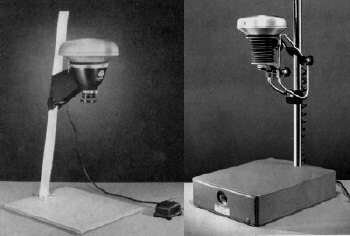 |
|
|||
| For decades, enlarger designers had fought the detrimental problem of heat from enlarger heads on negatives. Fluorescent technology promised reductions of heat, since the ballast used to excite the gases in fluorescent tubes could be located away from the illumination source greatly decreasing the amount of heat emanating from the tube itself. Kodak designers use the Circline fluorescent tube for the head design on two new Kodak enlargers--the entry level Hobbyist and the more advanced Flurolite. While I no longer have documentation about the Hobbyist, the manual for the Flurolite was printed in September, 1949. Perhaps Kodak offered both the Precision A condenser-based enlarger and the Flurolite coollight enlarger as complementary choices. The Flurolite manual is titled, "How to Use the Kodak Flurolite Enlarger A," so there was probably some thought at Kodak of offering a B 4 x 5 model to replace the Precision B. I am not aware that these were ever produced other than as prototypes, nor have I seen these mentioned in the Kodak newsletters that were issued to update the Kodak Reference Handbooks. The Hobbyist was my first enlarger. Based on my collection of Kodak Data Books and marketing information, I suspect it was released some time between 1950 and 1955. The design of the Hobbyist was basic--very basic. Construction was of the Brownie standard--a legitimate strategy for a company who had a goal of making photography available to everyone. The post is a square aluminum or steel tube turned 45° and mounted at an angle to the baseboard with a pressed metal flange. The mounting arm for the head is of sheet metal and the body is of either aluminum or perhaps a hard plastic. The lens is an 89mm f /6.3 Enlarging Ektanon mounted in a proprietary sleeve and focused by rotating this sleeve in the body. Work flow with this enlarger was dismal, since the fluorescent tube did not have a "self starter," so the head could not be connected to an auto timer. I had to watch either a spring wound timer or an electric clock with a sweep second hand to manually turn the enlarger on and off. While satisfying 13-year olds is not normally a reliable criteria for product evaluation, in this case I'd allow it. It did have the effect of wanting to make me trade up and that was with a Kodak product--the Flurolite. The Hobbyist and Flurolite share the same round negative carriers--either a series of glassless carriers or a glass-based combination carrier that used red masks. For the Flurolite, Kodak offered Color Head Adapter A that could accept 5-inch dye transfer or color balancing filters between the head and the negative or 2-inch square gelatine filters could be use in the holder just under the lens. |
||||
| Trading up from the Hobbyist to a Flurolite was a great improvement, since the Flurolite had a kind of fluerscent ballast that could be externally switched by an electric timer. The Flurolite has a substantial nickled steel post on a par with the Precision. The "arm" mounting the bellows/head to the post had been redesigned as a pair of trapezoidal metal tubes incorporated in a framework supporting height adjustment and focusing. The bellows/head is attached to the trapezoid with the same kind of standard tripod mount, so this assembly can be removed to allow use as a copy stand for cameras. The Flurolite uses the same 67mm square lensboard that Kodak had introduced on the Precision Enlargers. If you can't locate original equipment boards, these can be made from 50 mil aluminum sheet stock. The boards were not threaded so a lens retaining ring is necessary. The Hobbyist and the Flurolite share a similar head design; the Circline tube is in a dome-shaped clamshell structure with a brushed aluminum exterior finish and a highly reflective matte white interior--light and effective at reducing residual heat of the fluorescent tube. The sprung suspension for the trapezoid is powered by a long coil spring, tethered at one end to the inside of the post and traveling over a pulley mechanism in the top of the post and down to the trapezoid. The electric coil cord from the base to the head is a nice design detail. The bellows frame is cast aluminum and reminiscent of the Precision design but is of a different shape to allow for the different suspension system. While the Precision cloth bellows are substantial, I suspect mold could form in damp darkrooms. Flurolite bellows material is a rubber compound that is perhaps more resistant to cracking and more easily and effectively cleaned with a damp sponge. A paper safe in the base is very useful for storing open boxes of paper in current use. The door is spring loaded and is reliably lightproof. Based on my observation of the Kodak
coollight models and intrigued by the idea of a Flurolite Model B, I have
designed a coollight head for one of my 4x5 Precision enlargers that otherwise
has a large lamp housing and fan-cooled negative carrier frame. My DIY
lamp housing uses a shallow rectangular Radio Shack aluminum project box,
painted intense white inside and flat black outside, and a flat four-tube
compact fluorescent bulb. Four microprocessor heat sinks on the top of
the box and an external transformer make the power-cooled frame unnecessary.
Since this head is much more compact than the original, I've been imagining
a pretty compact 4x5 portable enlarger--imagine a Kodak Portable Minature
Enlarger kit on steroids. |
 |
|||
 08/06/2010 2:10 |
|
|||||